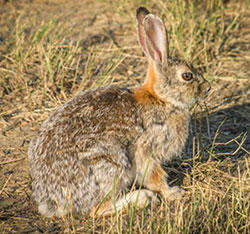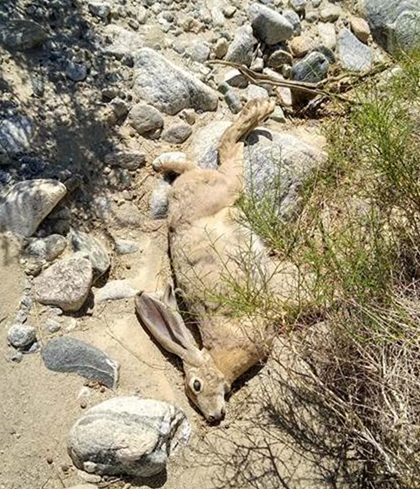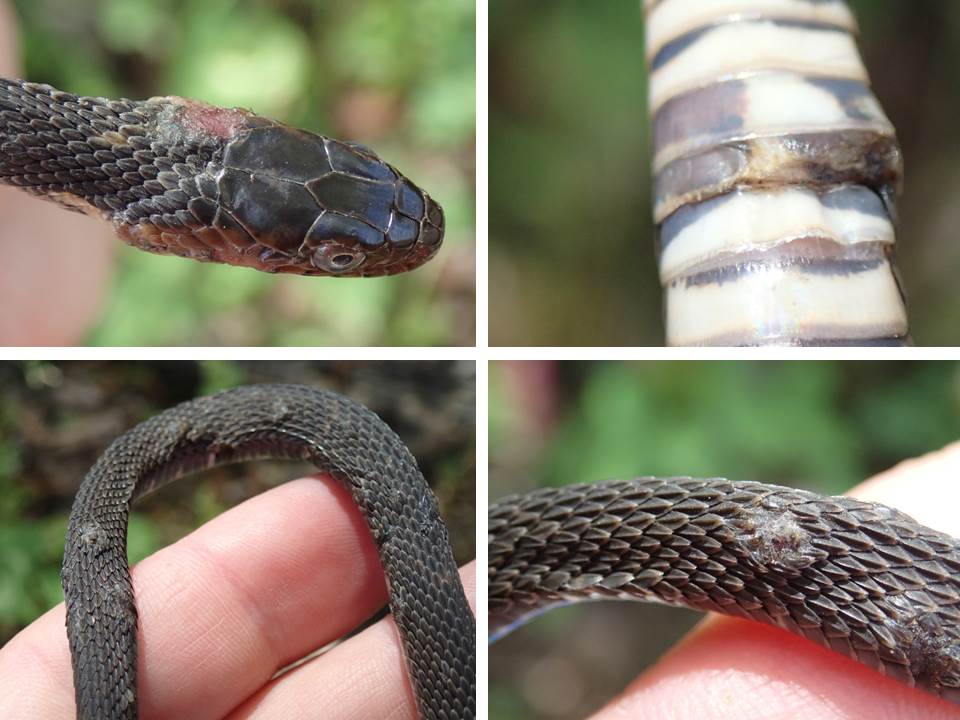Chronic Wasting Disease (CWD) is a fatal neurologic disease of cervids, that include deer, elk, and moose. This disease was first identified in wild deer and has been detected across the United States, Canada, Asia, and Europe.
CWD may negatively impact prey populations where it occurs and is a major wildlife conservation and management concern.
In 2024, CWD was detected in deer in California. It has the potential to spread to wild deer and elk populations in the state. CWD surveillance is a CDFW priority. Learn more about CWD and how to help!
Outbreaks of viral hemorrhagic disease (HD) are some of the most common and significant disease events affecting deer and are associated with three different viruses: Deer adenovirus-1 (also known as OdAdV-1, or Cervine adenovirus A), bluetongue virus (BTV), and epizootic hemorrhagic disease virus (EHDV). The disease caused by these viruses have many similar clinical signs and as the name implies, hemorrhages in various tissues are the classic lesions. The outcome in an individual deer can range from inapparent infections with little to no outward signs of disease to sudden death with significant variability in between. Deer adenovirus is the most important of these three viruses in California and the most likely to be associated with large mortality events. It is typically fatal to fawns and young deer and often causes less severe disease in adults, though it can cause death in all age groups.
Clinical Signs
Affected deer may have excessive salivation (drooling or foaming at the mouth), diarrhea, regurgitation, or seizures, but are often found dead without any obvious clinical signs. Multiple dead deer in an area over a short time period with these signs or found dead, particularly near water, may indicate an outbreak of hemorrhagic disease.
How it spreads?
Deer adenovirus is usually spread through direct contact between infected deer or contaminated bodily fluids from shared water or food source. Some outbreak dynamics and locations suggest that there may be other routes of transmission for deer adenovirus, such as through biting insects, but more research is needed to confirm this.
Bluetongue and epizootic hemorrhagic disease viruses are spread through biting midges. These are common viruses that affect cattle and other livestock and are regularly detected in California. They rarely cause large mortality events in deer and is endemic throughout the state so it is not a major concern.
Leaving out food, water, or salt licks can congregate animals and spread the disease so it is imperative to leave wildlife alone.
What to do if you see a sick deer?
Anyone who observes a deer exhibiting clinical signs, or encounters a deer that has died, can submit the information to CDFW through the Department's online mortality report form.
 Jackrabbit.
Jackrabbit.
On May 11, 2020, rabbit hemorrhagic disease virus serotype-2 (RHDV2) was confirmed in a wild black-tailed jackrabbit collected from an area where over 10 dead jackrabbits were found near Palm Springs, Riverside county. Since this initial report, RHDV2 in wild rabbits has been confirmed in the following California counties:
- Alameda (June 2021)
- Butte (February 2024)
- Colusa (November 2022)
- Inyo (July 2022)
- Glenn (November 2022)
- Kern
- Los Angeles
- Marin (September 2022)
- Mono (July 2022)
- Monterey (October 2024)
- Napa (November 2022)
- Orange
- Riverside
- Sacramento (December 2022)
- San Benito (December 2021)
- San Bernardino
- San Diego
- San Luis Obispo (June 2022)
- Santa Clara (February 2023)
- Solano (August 2022)
- Stanislaus (May 2022)
- Ventura (January 2025)
- Yolo (October 2022)
See also: USDA Interactive Map of RHDV2 affected counties
This highly infectious virus affects domestic and wild lagomorphs (members of the rabbit family). RHDV2 can spread quickly and can cause high mortality in affected rabbit populations.
To date, RHDV2 has been detected in domestic rabbits, wild cottontails, and jackrabbits, brush rabbit (including the endangered riparian brush rabbit) but all lagomorph species (including pikas) may be susceptible.
- RHDV2 poses no risk to humans or other animals.
- RHDV2 is spread through contact between infected rabbits, their meat or fur, respiratory fluids, urine, feces, contaminated soil or materials in contact with those items.
- RHDV2 can be easily spread to new areas by moving rabbits or contaminated items, and on shoes or clothing.
- RHDV2 may also be spread by insects and scavengers after contact with sick or dead rabbits.
Monitoring and Reporting
CDFW is tracking the geographic spread and impact of RHDV2 on wild rabbits, jackrabbits, and hares. Rabbits with RHDV2 may die quickly after infection. Blood may be present at the nose or mouth of the animal.
Help us monitor this new wildlife disease in California!
Please report sick or dead wild rabbits (2 or more) found in an area over a short period of time (3-4 days apart).
 Carcass Disposal and Handling.
Carcass Disposal and Handling.
ALWAYS use disposable glove and/or shovel if you must touch the carcass. Use 10% bleach solution (1 part bleach, 9 parts water) to spray gloves, shovel, and bottom of shoes prior to leaving area where rabbit was found to reduce risk of virus spread.
- Burial: Carcass should be buried (3 feet minimum) when possible.
- Incinerate: Carcass may be incinerated. Contact your local animal services agency. They may be able to dispose or incinerate carcasses. Services vary by location and there may be a charge.
- Landfill Disposal: Carcass may be double-bagged and disposed at a landfill. Spray outer bag with 10% bleach solution. Contact the landfill to ensure they will accept submissions. Local regulations and landfill services vary by location.
Resources
California is home to nearly 50 native snakes, including 13 species or subspecies listed as Species of Greatest Conservation Need. Many populations are often small, isolated, and vulnerable to infectious diseases. Snake Fungal Disease (SFD) is a newly emerging disease in snakes. It is caused by a fungus, Ophidiomyces ophidiicola.
- In 2019, California confirmed its first known case of SFD in a California kingsnake (Lampropeltis californiae) from Amador County. The snake was admitted to a wildlife rehabilitation center where care staff noted its poor condition and coordinated with CDFW to facilitate diagnostic testing.
- In October 2019, a second case was detected in a non-native Florida water snake (Nerodia fasciata pictiventris) collected in Sacramento County.
- In 2023, CDFW announced updated prevalence and distribution of O. ophidiicola and SFD in the state as a result of surveillance efforts that began in 2021.
- Since 2008, SFD has been detected in more than 30 snake species in North America and Europe. The fungus is present in at least 38 states. How SFD may impact snakes in California is unknown.
Report sick or dead snakes. Please include photos with your report, if possible to take photos from a safe distance. California’s native snakes thank you!
Symptoms and Signs

Sick snakes are often in poor condition and may rest in open areas where exposed to poor weather or predators. The fungal infection may cause the infected skin to shed repeatedly. Visible signs may include:
- Scabs, skin ulcers, or nodules
- Crusted or discolored scales
- Swollen or disfigured face
- Cloudy eyes (NOTE: eyes can also appear cloudy just prior to natural skin shedding)
Transmission
Snake-to-snake and contaminated environment-to-snake contact are the primary disease transmission routes. The fungus lives in soil. SFD can be transmitted to snakes through direct contact with other infected snakes, or from mother to offspring at birth in some species.
- DO NOT attempt to disturb or handle any snake—dead or live.
- DO NOT move soil from one location to another. The fungus may spread when people track contaminated soil on shoes and clothing.
- DO NOT release pet snakes into the wild. They can spread disease to native species. Don't let it loose, California!
CDFW works with wildlife rehabilitators, agency partners, and researchers to increase SFD surveillance in California. Biosecurity protocols are used to reduce risk of transmission when handling snakes. There is no evidence SFD is transmittable from snakes to humans. Help us monitor this new wildlife disease in California!
Resources
White-nose syndrome (WNS) is a disease caused by a fungus. WNS can kill up to 100% of bats in a colony during hibernation and has major conservation implications. Since 2006, the disease is estimated to have killed million of bats in the United States.
Until recently, the disease had spread slowly from its point of origin in upstate New York. In March 2016, WNS was confirmed in bats in the state of Washington. As part of a national surveillance program, samples were taken from bats at sites in northern California in 2018 and 2019.
In July 2019, the U.S. Fish and Wildlife Service and CDFW announced surveillance results suggesting the fungus that causes WNS is now present in California. Learn more!
In December 2021, Highly Pathogenic Avian Influenza (HPAI) H5N1 of Eurasian-lineage was detected in domestic poultry and wild birds along the Atlantic coast of Canada. In January and February 2022, detections were made for the first time in wild birds and domestic poultry in the eastern United States. Following its initial detection, the virus has spread to nearly every state with numerous detections in both domestic poultry and wild birds. The Wildlife Health Lab in coordination with regional staff and other partners are monitoring wild bird populations for signs of illness. Learn more!
The mission of the WHL is to investigate, monitor, and manage wildlife population health issues in California. WIHL staff responsibilities include the study and surveillance of zoonotic diseases.
Zoonotic disease are caused by harmful germs that can spread from animals to humans - such as viruses, bacteria, parasites, or fungi. Zoonotic diseases are common in the United States and around the world. Learn more about wildlife diseases in California!